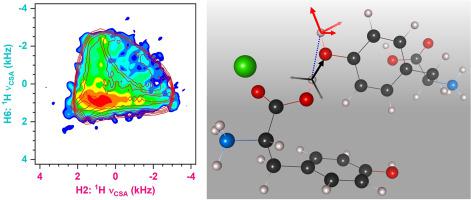Solid State Nuclear Magnetic Resonance ( IF 3.2 ) Pub Date : 2023-05-16 , DOI: 10.1016/j.ssnmr.2023.101874 Takeshi Kobayashi 1 , Yusuke Nishiyama 2 , Manoj Kumar Pandey 3

|
The mutual orientation of nuclear spin interaction tensors provides critical information on the conformation and arrangement of molecules in chemicals, materials, and biological systems at an atomic level. Proton is a ubiquitous and important element in a variety of substances, and its NMR is highly sensitive due to their virtually 100% natural abundance and large gyromagnetic ratio. Nevertheless, the measurement of mutual orientation between the 1H CSA tensors has remained largely untouched in the past due to strong 1H–1H homonuclear interactions in a dense network of protons. In this study, we have developed a proton-detected 3D 1H CSA/1H CSA/1H CS correlation method that utilizes three techniques to manage homonuclear interactions, namely fast magic-angle spinning, windowless C-symmetry-based CSA recoupling (windowless-ROCSA), and a band-selective 1H–1H polarization transfer. The asymmetric 1H CSA/1H CSA correlated powder patterns produced by the C-symmetry-based methods are highly sensitive to the sign and asymmetry parameter of the 1H CSA, and the Euler angle β as compared to the symmetric pattern obtained by the existing γ-encoded R-symmetry-based CSA/CSA correlation methods and allows a larger spectral area for data fitting. These features are beneficial for determining the mutual orientation between the nuclear spin interaction tensors with improved accuracy.
中文翻译:

确定通过快速 MAS 下的带选择性 1H-1H 耦合介导的质子 CSA 张量之间的相互取向
核自旋相互作用张量的相互取向提供了化学、材料和生物系统中分子在原子水平上的构象和排列的关键信息。质子是多种物质中普遍存在的重要元素,由于其几乎100%的自然丰度和大的旋磁比,其核磁共振具有很高的灵敏度。然而,由于质子密集网络中的强1 H- 1 H 同核相互作用,过去 1 H CSA 张量之间的相互取向测量基本上没有受到影响。在这项研究中,我们开发了质子检测的 3D 1 H CSA/ 1 H CSA/ 1H CS 相关方法利用三种技术来管理同核相互作用,即快速魔角自旋、基于无窗C对称性的 CSA 再耦合 (windowless-ROCSA) 和带选择性1 H– 1 H 偏振转移。由基于 C 对称性的方法产生的不对称1 H CSA/ 1 H CSA 相关粉末图案对1 H CSA的符号和不对称参数以及欧拉角β高度敏感,与通过现有γ编码的R- 基于对称的 CSA/CSA 相关方法,并允许更大的光谱区域用于数据拟合。这些特征有利于以更高的精度确定核自旋相互作用张量之间的相互取向。
































 京公网安备 11010802027423号
京公网安备 11010802027423号